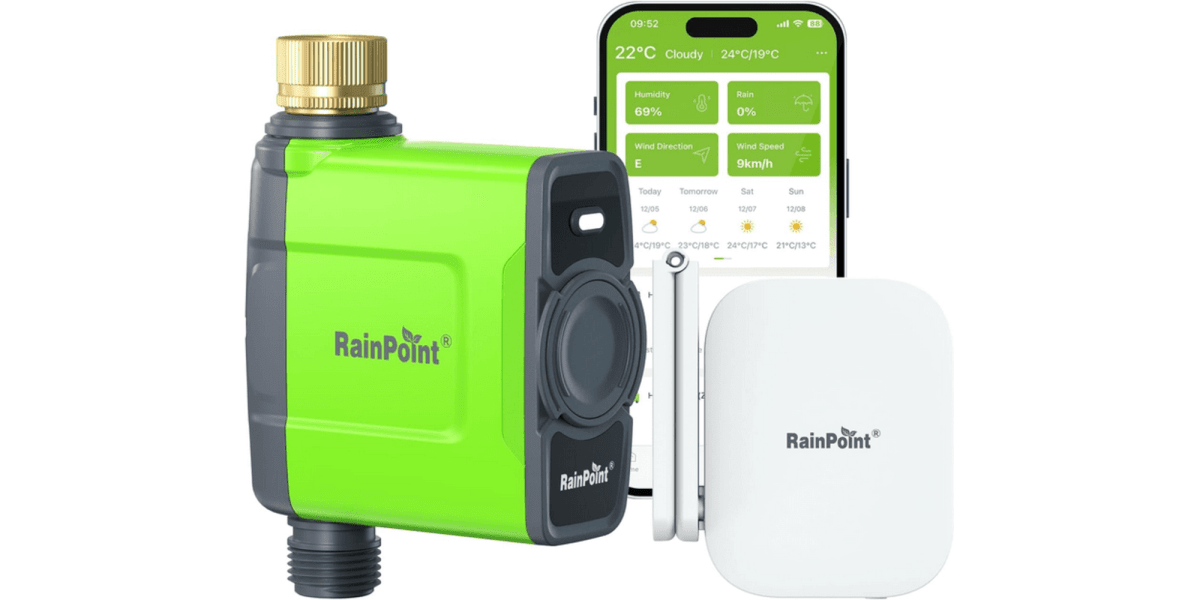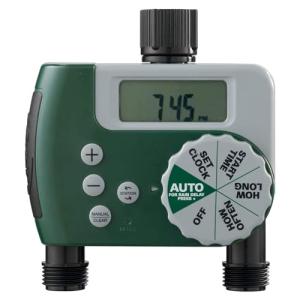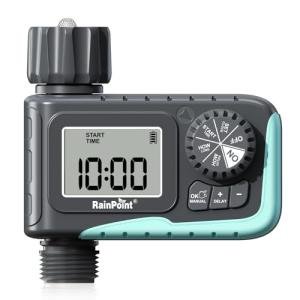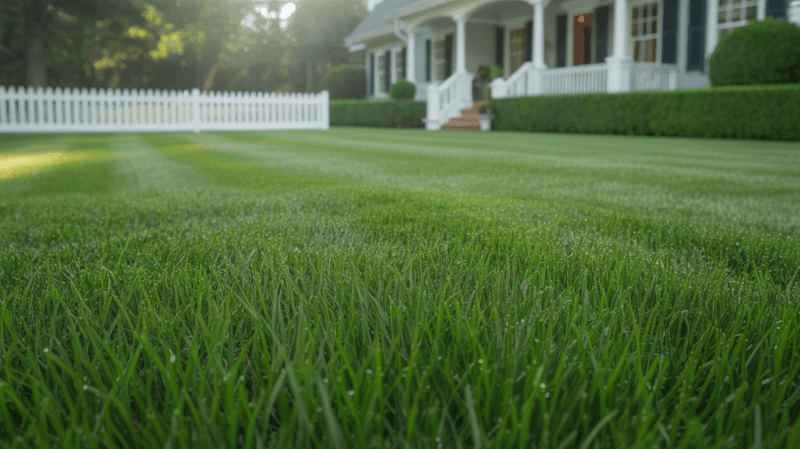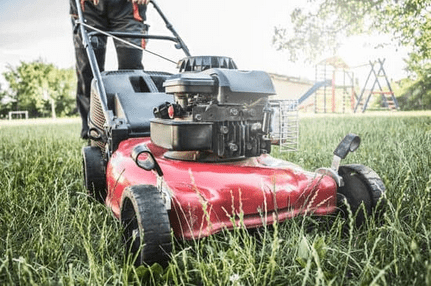Discover how the RAINPOINT WiFi Water Timer can simplify your garden care and save you time.
Keeping up with watering can be a hassle, especially if you travel or get busy. We set up the Rainpoint WiFi Water Timer in our garden and found it provided a hands-off way to manage watering directly from our phones.
Connecting the timer to WiFi and the app felt pretty simple. We could tweak the watering schedule, check usage, and make changes without stepping outside.
The option to skip watering when it rains saved us water, and honestly, it was a relief not to worry about overwatering. The app did have a learning curve, but the weather-based adjustments made it better than any manual timer we’ve tried.
The device felt sturdy in our hands, and it sent us alerts if anything went wrong. That kind of heads-up is always welcome.
Overview of the RAINPOINT WiFi Water Timer
Setting up this water timer took us just a few steps with the app and WiFi. Using the app, we controlled watering schedules from anywhere, making it easy to adjust to changes in weather or trips away from home.
The antenna gave us a stronger connection, so we didn’t lose signal as we moved around the yard. We liked that it adjusted watering based on weather, helping us avoid unnecessary watering on rainy days.
Pros:
- Simple remote control with the app
- Reliable WiFi connection and wide coverage
- Automatic weather-based adjustments
Cons:
- Needs a strong 2.4GHz WiFi signal
- App may take some time to learn
Key Features
Easy App Control & Setup
We found the setup process quick once we plugged in the gateway and downloaded the app. The instructions walked us through connecting to WiFi, and it only took a few minutes.
We adjusted watering times or switched to manual watering right in the app. The layout made it simple to check schedules or change settings, even from the couch.
Connecting only supports 2.4GHz WiFi, though, so that could trip up some folks.
Enhanced Connectivity with Antenna Gateway
The included antenna gateway provided us with a more stable connection than the other timers we've tried. Placing the gateway higher, like they suggest, made a big difference in coverage.
One cool thing: the gateway supports adding devices like soil and rain sensors. This let us monitor conditions and build a more tailored watering system.
Pairing with other devices took some trial and error, but once we got it right, everything worked together nicely.
Smart Weather-Based Irrigation
We appreciated how the system utilizes real-time weather data to prevent unnecessary watering. On rainy days, it automatically skipped our scheduled routine.
During a dry spell, it adjusted timings to keep things on track. Our plants seemed happier with this approach—it helped prevent both overwatering and underwatering.
The weather-based adjustments aren’t flawless sometimes they miss a skip if local weather data lags. Still, we noticed real savings in water use.
Multiple Watering Modes
We tried out several modes depending on what our plants needed. The normal schedule was suitable for general use, but the interval and cycle & soak options worked particularly well for flower beds and trees.
Here’s a quick summary of what we saw:
| Mode | When We Used It | Frequency Options |
|---|---|---|
| Normal Irrigation | Daily lawn or garden watering | Daily, weekly, etc. |
| Interval | Short bursts for new plantings | Every few seconds/minutes |
| Cycle & Soak | Deep watering for trees/shrubs | Up to 12 hours |
Options for odd and even days, as well as custom schedules, provided us with flexibility. Setting up more complex schedules in the app required some patience, but the different modes allowed us to match watering routines to the yard's needs.
Flow Monitoring & Real-Time Alerts
We immediately noticed how easy it was to track water usage with this timer. The flow monitoring feature showed us exactly how much water our garden got, right in the app.
It stores water usage data for the past year, making it easy to check our habits. Real-time alerts were super helpful. If there was a problem, such as the valve not opening or closing, we received a message on our phones.
Pros:
- Detailed water usage tracking
- Alerts make it easy to spot issues fast
Cons:
- We did get a few false alarms when the WiFi was spotty
Build Quality & Durability
When we handled the Rainpoint timer, it felt solid and well-made. The brass inlet and rubber ring help prevent leaks and thread damage key for outdoor gear.
The IP65 waterproof rating indicates that it can withstand rain and dust without issue. We appreciate the weather-resistant structure it withstands the sun, wind, and wet conditions well.
The upgraded coil valve appears to be reliable and provides a steady water flow. The plastic housing is sturdy, but it’s not as tough as all-metal models. For most gardens, though, it should hold up just fine.
Pros and Cons
Pros
Setup was a breeze. The app connected quickly, and we liked handling watering from our phones instead of having to run outside.
Remote management felt smooth. Scheduling watering for different days and times made it easy to keep our plants happy, even when we were away.
The automatic weather adjustments worked well. If it rained, the timer would skip watering and send us a notification. That saved us water and avoided overdoing it.
The strong connection from the antenna meant we didn’t have to worry about losing signal. We also appreciated being able to see exactly how much water we used, thanks to the built-in flow monitor.
Cons
We did hit a couple of snags. The timer only works with 2.4GHz WiFi, not 5GHz, so we had to check our router settings.
If the gateway isn’t set up high or is near metal, it loses its signal. That could be a hassle for some setups.
The app took a little time to get used to. There was a short learning curve before we felt comfortable with all the features.
The price may be slightly higher than some basic water timers, but the additional features help justify it.
Summary Table
| Pros | Cons |
|---|---|
| Easy to set up and use | Only supports 2.4GHz WiFi |
| The app provides remote controls | The app has a learning curve |
| Weather-based auto adjustments | Signal issues if the gateway is poorly placed |
| Reliable antenna connection | Higher price than basic timers |
| Tracks water usage |
Customer Reviews
From what we've seen, people who try this Rainpoint timer usually appreciate its sturdy feel and ease of setup. Many users say the smart features, like remote control with the app and adjusting schedules for rainy days, are genuinely helpful.
Some customers use multiple timers for different areas of their yard and appreciate being able to manage everything from a single app. Most reviewers mention the brass inlet as a plus for durability.
A few people mentioned that setting up the WiFi connection took longer than expected. Still, once running, the device seems reliable for watering needs. Customer impressions suggest it works well for both small and larger gardens.
Frequently Asked Questions
How does the RainPoint WiFi Water Timer integrate with smart home systems?
We found that the RainPoint integrates mainly with its own RAINPOINT HOME app, which connects the water timer to your WiFi network. It doesn’t support Alexa or Google Home, so users wanting voice control or advanced ecosystem features might be out of luck.
The connection using the included gateway is strong and stable, especially if you keep it away from metal and off the floor.
Is the RainPoint app user-friendly for scheduling and controlling the watering timer?
Using the app felt straightforward after setup. Scheduling features were easy to find, and adjusting watering times or modes only took a few taps.
We appreciated that the app provided notifications about water flow issues or when the valve remained open. There might be a slight learning curve for those new to smart home technology, but daily use felt smooth and intuitive.
Pros of the app:
- Easy to adjust and set schedules
- Notifies about problems right away
Cons:
- Requires 2.4GHz WiFi, no 5GHz support
- Only works through RAINPOINT’s system
What are the key features that distinguish the RainPoint WiFi Water Timer from competitors?
A few details make the RainPoint stand out:
- The built-in flow sensor tracks water use and sends real-time alerts for unusual activity. This helps us avoid waste and potential leaks.
- There are three different watering modes for more flexibility than most basic timers.
- The automatic, weather-based watering adjustment is useful for saving water and eliminating the guesswork associated with scheduling.
Some similar devices offer voice assistant support, which this one doesn’t. Still, if you care about tracking and smarter watering, RainPoint delivers strong value.
Can the RainPoint WiFi Water Timer handle multiple watering zones?
Currently, the RainPoint timer manages one zone per device. If you want to control several areas, you’ll need extra timers. The app allows you to manage multiple RainPoint devices simultaneously, enabling grouping by flower bed or lawn, but this feature comes at an additional cost.
This setup offers flexibility for expansion, but it is not as straightforward as some multi-zone systems.
What are the power requirements and battery life expectancy for the RainPoint WiFi Water Timer?
- Power: The timer runs on batteries (usually two AA batteries for this type).
- Battery Life: Battery life depends on usage and climate; however, in moderate conditions, we expect several months before replacement is necessary.
We found that heavy use, such as frequent cycles or active flow alarms, can reduce battery life. The device will alert you through the app when batteries get low, which helps prevent interruptions.
How does the RainPoint WiFi Water Timer perform in different climate conditions?
We ran the RainPoint through a series of weather tests, and honestly, it performed better than we expected. Its IP65 waterproof rating and sturdy construction help it survive both rainstorms and blazing sun.
The sealing and brass inlet do a solid job of protecting against leaks and corrosion. If you live somewhere with harsh winters, though, you’ll want to bring the timer inside before the water freezes; frozen water can damage almost any irrigation gear.
Performance highlights:
- Handles heavy rain, heat, and regular garden use without fuss
- We didn’t spot any leaks or real wear after several weeks outside
- Best to store indoors if you’re expecting icy weather
DISCLAIMER
This document is provided for general information purposes only and should not be relied upon as providing legal advice, technical, or specific operational guidance to the reader, whether as to the practices described in the document or the applicable legal requirements and regulations. lawnfly.com expressly disclaims any responsibility for liability arising from or related to the use or misuse of any information in this document.
